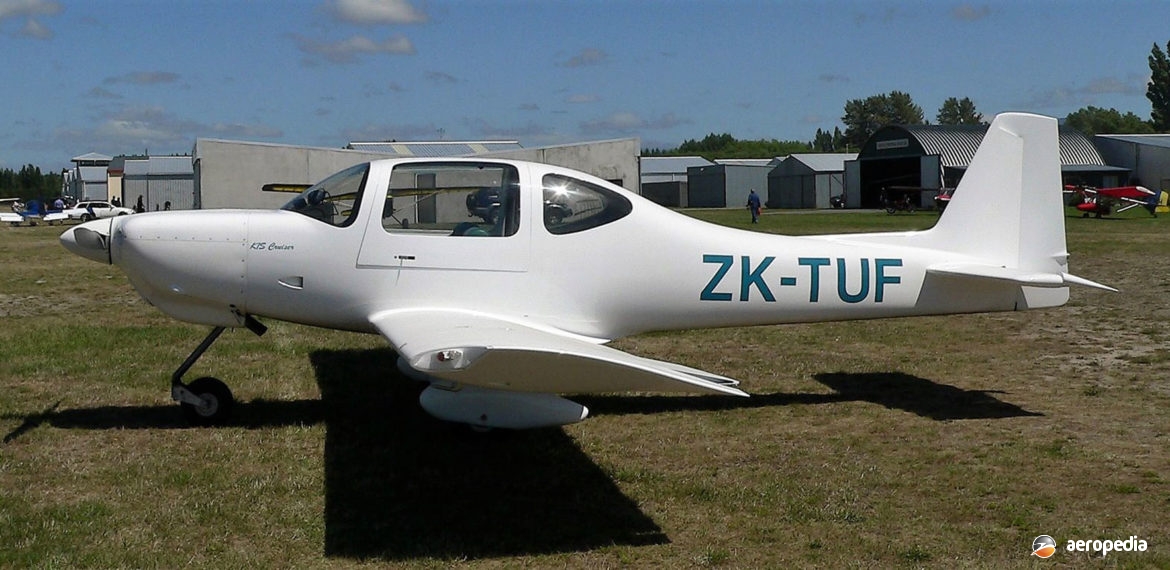Photograph:
Tri-R KIS Cruiser ZK-TUF (c/n 44) at Rangiora, New Zealand in July 2010 (L N Tuff – NZCIVAIR)
Country of origin:
United States of America
Description:
Four-seat cabin monoplane
Power Plant:
One 134 kw (180 hp) Lycoming O-360 four-cylinder horizontally-opposed air-cooled engine
Specifications:
- Wingspan: 8.8 m (29 ft)
- Length: 7.01 m (23 ft)
- Height: 2.19 m (7 ft 2 in)
- Wing area: 12.5 m² (135 sq ft)
- Max speed: 314 km/h (195 mph)
- Cruising speed: 282 km/h (175 mph)
- Stalling speed: 88 km/h (55 mph)
- Rate of climb: 366 m/min (1,200 ft/min)
- Service ceiling: 5,182 m (17,000 ft)
- Range: 1,713 km (1,065 miles)
- Take-off run: 579 m (1,900 ft)
- Landing run: 411 m (1,350 ft)
- Fuel capacity: 193 litres (43 imp gals)
- Empty weight: 544 kg (1,200 lb)
- Loaded weight: 1,089 kg (2,400 lb)
History:
The TR-4 Cruiser was a development of the TR-1 and TR-2 KIS produced by Tri-R Technologies Inc of Oxnard, California which was produced in kit form for the amateur constructor and could be fitted with a variety of engines. Of similar construction to the smaller aircraft, the four-seat Cruiser was usually fitted with a 134 kw (180 hp) Lycoming O-360 engine and, by the end of 1998, some 140 kits had been sold. At that time the Company announced it was producing a KIS Super Cruiser, to be fitted with a 157 kw (210 hp) Continental IO-360 engine driving a McCauley constant speed propeller, gullwing doors and a new, stronger nosegear. The kit contained all materials required to complete the airframe, the parts being constructed of high-temperature epoxy resin pre-impregnated fibreglass with carbon fibre, honeycomb core material, these parts being vacuum-pressured and cured. The wing was built with a three-piece spar, one in each wing and a centre spar that traversed the fuselage, the three pieces held together by two bolts in each wing. Baggage capacity was 29.5 kg (65 lb).
In 2001 the manufacture and marketing of the type was taken over by Pulsar Aircraft Corp of El Monte, California, this company developing the design and producing new models. Three engines could be installed, the 119 kw (160 hp) Lycoming O-320, the 134 kw (180 hp) Lycoming O-360, and the 157 kw (210 hp) Continental 360. The latter Super Cruiser had an empty weight of 572 kg (1,260 lb), a gross weight of 1,089 kg (2,400 lb), a useful load of 517 kg (1,140 lb) and cruised at 322 km/h (200 mph) at sea level. It had a stalling speed in landing configuration of 92 km/h (57 mph) and range was 1,287 km (800 miles) with reserves.
First Cruiser seen in this region was ZK-TEL (c/n 4017) registered to Scientific Management New Zealand Ltd of North Shore, Auckland on 17 February 1999, making its first flight on 3 March 1999. This was followed by ZK-TUF (c/n 44) built in Christchurch and registered to Laurie Tuff on 10 April 2000, being fitted with a Lycoming IO-360A engine. A further example became ZK-PLN (c/n 4009 – ex ZU-BLN), this aircraft having been built in South Africa where it operated as ZU-BLN. It was first registered there on 22 December 1997 before it was imported to New Zealand, becoming ZK-PLN on 24 April 2004 and has been based at Ardmore.

